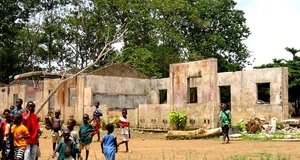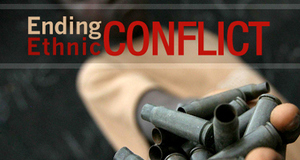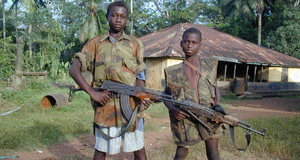Featured Article:Idle Youth: Using Sport to Address the Youth Bulge in Sierra Leone
By
2010, Vol. 2 No. 05 | pg. 5/5 | « ConclusionWhilst this paper is chiefly concerned with how to prevent conflict through the relatively cheap medium of sport, it is in fact only touching on a much deeper challenge of how to make structural adjustments that can satisfactorily occupy a youth bulge which evidence shows us is prone to violence. Furthermore it is impossible to talk about rebuilding and repairing the structural deficiencies without placing these ills within the context of the post cold-war insecurities. In the first ten years after the world shifted from a bipolar to uni-polar system, there was an apparent ‘tendency towards disintegration’99 in West Africa that increased the risk of violence. The spiralling cruelty in the region forced first the conflict resolving and second the conflict preventative hands of the west who grasped that ‘an ounce of prevention was worth a pound of cure.’ It is now accepted that the longer the delay in intervening, the higher the cost in terms of human life and damage to property. Moreover, the more violence escalates, the more difficult it becomes to resolve a conflict.100 Therefore as a precursor to more reaching political intervention and reform, sport must be viewed as transitional medium of engagement that can ease social tensions and increase the populace’s susceptibility to further conflict preventative measures. At its most basic level sport can convene youths– perhaps to an unmatched level in Sierra Leone. Where possible, sport should be integrated as part of the curriculum to entice children to school, to maintain their concentration levels once they are there, and to offer diversity of opportunity for children. Away from schools, sport can supplement other forms of education or vocational training and provide a more holistic syllabus that improves one’s social skill-set and employability.However sport for development programs do not create many jobs directly. Furthermore, the outward, exiting gaze of talented sportsmen and women, not to mention fans, has left the national sports system in tatters. More worryingly, dreams of exit do not appear to be solely reserved to those with sporting ability: George Bah, a seventeen year old youth whom I interviewed in Lumley, Freetown, is one of the brightest at his school just off Babadori Road. He believes ‘education, not sport, is the vehicle to improve your life, and that focussing on languages is what will open doors for you.’ However, like those youths harbouring dreams of playing in the European football leagues, George sees his academic ability as a ticket to exit Sierra Leone and earn a living abroad, ‘hopefully the US.’101 Indeed of the many youths I spoke to, an alarming proportion saw exiting the state as the best way to improve their lives. This dejection is in part caused by the divide between youths and adults that is as much cultural as it is numerical. ‘Whilst we consider ourselves productive, creative, and energetic in the community,’ said Henrose Vandi, a Fourah Bay College Poverty & Conflict student, ‘adults think we are troublemakers. Divisions exist at social gatherings, clubs, the sports fields, community events, the churches or mosques, and at the beach.’ Tellingly, Miss. Vandi identified this social schism as the root of Sierra Leone’s underdevelopment and looked outside of her country for the answers. ‘The Europeans treated their youths correctly,’ she said; ‘They empower youths and develop whilst Africa does not.’102 What therefore appears to be needed are certain balances: Firstly, sport must be offered both within the curriculum and in youth organisations outside of schools, but by no means must sport and its known benefits supplant the education system. Secondly, there must be a governmental premium placed on education, but at the same time if it is to persuade the most talented of an ever restless youth to stay in the country it must improve the national conditions and available economic opportunities for youths once they leave the education system. Thirdly, to force these changes, we should look to my original prognosis that attitudinal change and a belief in the recuperative power of voice above exit is what is needed if Sierra Leone’s brightest and fittest youths are to remain in the country and contribute to its future. Yet this negative view ignores the potential of having such a huge youth population. Youths have a lot of energy and potential that Sierra Leone can harness for development, but this can only be realised in an environment where the youth question is at the very top of the agenda. A comprehensive national strategy with coordinated targeting of key socio-economic groups could mobilise the youth and reinvigorate the economy. Sport can form part of the solution. It prepares the youth for responsible leadership and educates them about their rights, responsibilities, and what society expects of them as law abiding citizens. Appropriately, it also involves youths in decision making processes and makes them accountable stakeholders in their own futures. Realising this potential will depend upon four dimensional coherence at the policy level. This will ensure the right policies are formulated and will establish the relevant channels of dialogue to implement them with more impacting results. Internationally, this policy formation emanates from The United Nations Sport for Development and Peace International Working Group (SDP IWG). The SDP IWG looks to engage national governments, UN agencies and civil society in the development of realistic recommendations for the integration of Sport for Development and Peace initiatives into domestic and international development policies. In short, the SDP IWG is a functioning testimony to the conflict preventative role sport has to play in the field. Its mandate is as follows: To articulate and promote the adoption of policy recommendations to national governments for the integration of sport and physical activity into their national and international development strategies and programs. Sport for Development and Peace evolved from a growing body of evidence showing that well-designed sport-based initiatives incorporating the best values of sport can be powerful, practical and cost-effective tools to achieve development and peace objectives. Sport is now recognized by many international experts in the fields of development, education, health, sport, economics and conflict resolution as a simple, low cost, and effective means of achieving a diverse range of development goals.103 Furthermore the SDP IWG recognises sport’s potential to contribute to ‘attaining the Millennium Development Goals and related development objectives in the areas of: child & youth development and education; health; the inclusion and wellbeing of people with disabilities; gender equity and the empowerment of women and girls; and conflict prevention and peace-building.’104 I would argue that part of sport’s ability to be so useful across these various areas must be attributed to the not insignificant mimicry between sport and war. For example Right To Play’s network of coaches and trainers act as guides for the children and youths in a multi-functioning role that in many ways is parental and as such is reminiscent of how the RUF treated children during the civil war.105 Therefore sport programs provide a familiar hierarchical structure of education and guidance that maximises the effect of the programs and allows the right balance of room for expression and quality of direction. Conflict prevention is not a science, but instead reliant upon educated assumptions based on extensive research and the lessons of experience. What is certain is that, economically speaking, a youth bulge has the potential to be a tremendous boon to any nation that handles it correctly and manages to include all its members in a functioning and supportive society. It is seemingly a matter of incorporating everyone in decision making processes and ensuring the right balance between economic and human development. This will go some way to forging a meaningful social contract between the government and the youth that provides a powerful disincentive for the latter to use exit over voice as the primary agent of social change. As I said in my introduction, it was not my intention to make sweeping policy recommendations, rather to ‘merely add some new ideas to the growing body of research into conflict prevention.’ During this study certain factors have come to the fore that I hope may contribute to this body. Some are specific to Sierra Leone and are products of its civil war, its political history and structures, and its economic predicament, and they shall not be listed here. However the following recommendations are perhaps born of more general and transferable lessons of how to avert conflict resulting from demographic pressures:
ReferencesAdebajo, Adekeye and Ismail Rashid, ed., ‘West Africa’s Security Challenges: Building Peace in a Troubled Region,’ International Peace Academy, 2004. Ali, Taisier M. and Robert O. Matthews, ed., ‘Durable Peace: Challenges for Peace Building In Africa,’ Toronto: University of Toronto Press, 2004. Allison, Lincoln, ‘The Politics of Sport,’ Manchester: Manchester University Press, 1986. Anderson, Mary, ‘Do no harm: How aid can support peace– or war,’ London: Lynne Reinner, 1999. Berdal, Mats and M. Malone, ed., “Greed and Grievance, Economic Agendas in Civil Wars”, International Peace Academy, London: Lynne Reiner, 2000. Caplan, Richard, ‘International Governance of war-torn territories,’ Oxford: Oxford University Press, 2005. Cincotta, Richard P., Robert Engelman, and Daniele Anastasion, ‘The security demographic: Population and civil conflict after the cold war,’ Washington, DC: Population Action International, 2003. Collier, Paul. ‘The Bottom Billion: Why the poorest countries are failing and what can be done about it,’ Oxford: Oxford University Press, 2007. Collier, Paul, and Anke Hoeffler, ‘Greed and Grievance in Civil War,’ Washington D.C: World Bank, 2000. Dobbins, James et al, ‘The UN’s Role in Nation-Building from the Congo to Iraq’, The Rand Corporation, 2005. Duffield, Mark, ‘Global Governance and the New Wars,’ London: Zed Books, 2001. Elias, Norbert, ‘The Sociology of Sport; a selection of readings,’ London: Frank Cass, 1971. Florquin, Nicolas and Eric G. Berman, ed., ‘Armed and Aimless: Armed Groups, Guns, and Human Security in the ECOWAS Region,’ London, 2005. Gberie, Lansana, ‘A Dirty War in West Africa: the RUF and the destruction of Sierra Leone,’ London: Hurst and Co, 2005. Hampson, Fen Osler and David M. Malone, ed., ‘From reaction to conflict prevention:opportunities for the UN system,’ London: Lynne Reinner, 2002. Hirschmann, Albert. O, ‘Exit, Voice and Loyalty. Responses to Decline in Firms, Organizations, and States,’ Massachusetts: Harvard University Press, 1970. Hobsbawm, Eric, ‘Bandits’, London: Penguin, 1972. Hobbes, Thomas, ‘Leviathan’, first printed 1651, C.B. MacPherson (ed), London: Harmondsworth, 1968. Holt, R, J.A Mangan, Pierre LaFranchi, ‘European Heroes: Myth, Identity and Sport,’ London: Frank Cass, 1996. Independent Working Group on the future of the United Nations, ‘The United Nations in its second half-century,’ 1995. International Crisis Group (ICG), ‘Sierra Leone: The state of Security and Governance,’ Freetown/Brussels, September 2nd 2003. Keen, David, ‘Conflict and Collusion in Sierra Leone,’ A project of the International Peace Academy, New York: Palgrave, 2005. Kaldor, Mary, ‘On New and old Wars: organized violence in a global era,’ California: Stanford University Press, 2007. Licklider, Roy, ed., ‘Stop the Killing: How Civil Wars End,’ New York: New York University Press, 1993. Mack, Andrew, ed., ‘Human Security Report 2005,’ Human Security Centre in association with the University of British Columbia, Canada, 2005. Mangan, J.A, ‘Tribal Identities: Nationalism, Europe and Sport,’ London: Frank Cass, 1996. McInnes, Colin, ‘Spectator Sport Warfare– the West and Contemporary Conflict,’ London: Lynne Reiner, 2002. Pařivá, J and A. P. Hills, ed., ‘Physical fitness and nutrition during growth:studies in children and youth in different environments,’ Basel;New York:Karger,1998. Smillie, Ian, Lansana Gberie and Ralph Hazleton, ‘The Heart of the Matter: Sierra Leone, Diamonds and Human Security,’ Toronto: Partnership Africa Canada, 2000. Stewart, Frances, ‘Horizontal Inequalities and Conflict: Understanding Group Conflict in Multiethnic Societies,’ Basingstoke: Palgrave Macmillan, 2008. Stewart, Frances, ‘Horizontal inequalities:a neglected dimension of development,’ Helsinki:United Nations University, World Institute for Development Economics Research (UNU/WIDER),2001. Frances Stewart, ‘Human Development and Security,’ Conflict, Security and Development, Vol.4, no.3, 2004. Tilly, Charles, ‘The Politics of Collective Violence,’ Cambridge: Cambridge University Press, 2003. Traub, James, ‘The worst place on earth,’ New York: The New York Review of Books, June 29th, 2000. Urdal, Henrik, ‘A clash of generations? Youth bulges and political violence,’ International Studies Quarterly 50, pp.607-629, 2006. Van Creveld, Martin, ‘The Transformation of War: the most radical reinterpretation of armed conflict since Clausewitz’, New York, 1991. Van de Goor, Luc, et. al., ‘Between Development and Destruction,’ London: Macmillan, 1996. Van der Veen, Roel, ‘What went wrong with Africa,’ Amsterdam: Kit Publishers, 2004. Von Clausewitz, Carl, ‘On the Nature of War’, tr & ed. J. Graham, London: Penguin, 2005. Von Clausewitz, Carl, ‘On War’, tr. & ed. Michael Howard & Peter Paret, New Jersey: Princeton University Press, 1976. Willis, Katie, ‘Theories and Practices of Development,’ Oxford: Routledge, 2005. Endnotes1.) Henrik Urdal, ‘A clash of generations? Youth bulges and political violence,’ International Studies Quarterly 50, 607-629. Cincotta et al., 2003. 2.) Richard P. Cincotta and Elizabeth Leahy, ‘Population Age Structure and Its Relation to Civil Conflict: A Graphic Metric,’ in the Wilson Center’s ‘ECSP Report,’ Volume 12, p.54. 3.) Richard P. Cincotta and Elizabeth Leahy, ibid, p.55. 4.) What exactly constitutes ‘youth’ will be defined in due course, but loosely it is someone between eighteen and thirty years old. However this numerical classification will be challenged, for not only is its rigidity too exclusive of national variations on factors such as life expectancy, it also ignores the cultural attachments of what it means to be a youth. Furthermore, numerically in Sierra Leone a youth is in fact considered to be anyone between eighteen and thirty-five, not thirty. 5.) Roel van der Veen, ‘What went wrong with Africa,’ p.255. 6.) ‘Funmi Olonisakin, ‘Children and Armed Conflict,’ in Adekeye Adebajo and Ismail Rashid, ed., ‘West Africa’s Security Challenges: Building Peace in a Troubled Region,’ p.248. 7.) ‘Funmi Olonisakin, ibid, p.248. 8.) ‘Funmi Olonisakin, ibid, p.248. 9.) Frances Stewart, ‘Human Development and Security,’ Conflict, Security and Development, Vol.4, no.3. 10.) Frances Stewart, ibid. 11.) Paul Collier and Anke Hoeffler, ‘Greed and Grievance in Civil War.’ 12.) Paul Collier, Lani Elliott, Håvard Hegre, Anke Hoeffler, Marta Reynal-Querol, Nicholas Sambanis, ‘Breaking the Conflict Trap.’ 13.) Charles Tilly, ‘The Politics of Collective Violence.’ 14.) ‘Encouraging Effective Evaluation of Conflict Prevention and Peacebuilding Activities: Towards DAC Guidance,’ http://www.adb.org/Documents/Papers/DAC-Guidance/Approach-DAC-Guidance.pdf , p.7 15.) ‘Towards DAC Guidance,’ ibid, p.7. 16.) Utstein Group, Overview report of the Joint Utstein Study of Peacebuilding, ‘Towards a Strategic Framework for Peacebuilding: Getting Their Act Together.’ 17.) ‘Sierra Leone National Youth Policy,’ 2005, p.2. 18.) Conflict, Security and Development Group, ‘Yovex 2,’ King’s College University, London. 2008. 19.) Interview with Moses J. Johnson, Right To Play Project Manager, Freetown, Sierra Leone, May 29th 2008. 20.) Interview with Abraham Foday-Kai, politician and son of a chief from Kono district, Freetown, Sierra Leone, June 1st 2008. 21.) Interview with Dr. Prince Cummings, Right To Play Country Manager, Freetown, Sierra Leone, June 2nd 2008. 22.) Conflict, Security and Development Group, ‘Yovex 2,’ King’s College University, London. 2008. 23.) Interview with Moses J. Johnson, Right To Play Project Manager, Freetown, Sierra Leone, May 29th 2008. 24.) Right To Play Progress Report 2008, 'Results,' p.10. 25.) Right To Play Progress Report 2008, 'Results,' p.10. 26.) Interview with Richmond Thorley, Secretary and President of the Sierra Leone Teacher’s Union (SLTU), Makeni, Sierra Leone, June 4th 2008. 27.) Quoting Yovex 2. 28.) ‘Sierra Leone National Youth Policy,’ 2005, p.15. 29.) Albert O. Hirschmann, ‘Exit, Voice and Loyalty. Responses to Decline in Firms, Organizations, and States,’ p.23. 30.) Albert O. Hirschmann, ibid, p.37. 31.) Albert O. Hirschmann, ibid, p.16 32.) Mary Kaldor, ‘On New Wars.’ 33.) Mohammed Ayoob, ’State Making, State Breaking and State Failure: Explaining the Roots of ‘Third World’ Insecurity,’ in Luc van de Goor et. Al, Between Development and Destruction, pp.67-90. 34.) Andrew Mack (ed), Human Security Report 2005, p.10. 35.) Richard P. Cincotta and Elizabeth Leahy, ‘Population Age Structure and Its Relation to Civil Conflict: A Graphic Metric,’ in the Wilson Center’s ‘ECSP Report,’ Volume 12, p.55. 36.) Ismail Rashid in Adekeye Adebajo and Ismail Rashid, ed., ‘West Africa’s Security Challenges: Building Peace in a Troubled Region,’ p.388-9. 37.) Ismail Rashid, ibid, p.390. 38.) Ismail Rashid, ibid, p.389. 39.) ‘Funmi Olonisakin, ibid, p.253. 40.) Roel van der Veen, ‘What went wrong with Africa,’ p.159. 41.) Cyril Foray, 1998, in Lansana Gberie, ‘A Dirty War in West Africa: the RUF and the destruction of Sierra Leone,’ p.196. 42.) Collier, Paul, and Anke Hoeffler, ‘Greed and Grievance in Civil War.’ 43.) Katie Willis, ‘Theories and Practices of Development,’ p.10. 44.) Katie Willis, ibid, p.13. 45.) The Basic Needs Approach, quoted in Katie Willis, ibid, p.93. 46.) Interview with Emmanuel M. Conteh, War Child, Freetown, Sierra Leone, 2nd June 2008. 47.) Katie Willis, ‘Theories and Practices of Development,’ p.99 48.) Katie Willis, ‘ibid,’ p.99. 49.) Colin McInnes, ‘Spectator Sport War– the West and Contemporary Conflict,’ p.75. 50.) See footnote 35. 51.) Mark Duffield, ‘Global Governance and the New Wars: The Merging of Development and Security,’ quoted in Robert Picciotto, ‘Pulling Things Together,’ Conflict Prevention and Peace Building Option, King’s College University, p.4 52.) Mary Anderson, ‘Do no harm: How aid can support peace– or war.’ 53.) For deeper analysis of how multi-donor and government agencies in Sierra Leone are trying to harmonise and align their policies, please see chapter 5. 54.) Citing Andy Brooks, UNICEF, in David Keen, ‘Conflict and Collusion in Sierra Leone,’ p.260. 55.) ‘Funmi Olonisakin, ‘Children and Armed Conflict,’ in Adekeye Adebajo and Ismail Rashid, ed., ‘West Africa’s Security Challenges: Building Peace in a Troubled Region,’ p.247. 56.) Dennis Bright speaking at, ‘Sierra Leone: The Conflict and the World,’ CODEP Conference, 18-20 June 2001, SOAS, quoted in David Keen, ‘Conflict and Collusion in Sierra Leone,’ p.260. 57.) Martin van Creveld, ‘The Transformation of War: the most radical reinterpretation of armed conflict since Clausewitz,’ p.191. 58.) Colin McInnes, ‘Spectator Sport War– the West and Contemporary Conflict,’ p.149. 59.) Lincoln Allison, ‘The Politics of Sport,’ p.14. 60.) Jean Michel Faure in J.A Mangan, ‘Tribal Identities: Nationalism, Europe and Sport,’ pp.77-8. 61.) Katie Willis, ‘Theories and Practices of Development,’ p.8. 62.) Interview with Moses J. Johnson, Right To Play Project Manager, Freetown, Sierra Leone, May 29th 2008. 63.) Colin McInnes, ‘Spectator Sport War,’ p.148. 64.) Lincoln Allison, ‘Sport and Politics,’ in Lincoln Alison, ed., ‘The Politics of Sport,’ pp1-26. 65.) Eric Hobsbawm, ‘Bandits,’ p.10 66.) ‘Sierra Leone National Youth Policy,’ 2005. p.5. 67.) Right To Play Progress Report 2008, 'Results,' p.6. 68.) ‘Sierra Leone National Youth Policy,’ 2005. p.5. 69.) ‘Sierra Leone National Youth Policy,’ 2005. pp.5-6. 70.) ‘Sierra Leone National Youth Policy,’ 2005. p.6. 71.) Interview with Emmay Mah, Save the Children Project Manager, Freetown, Sierra Leone, 30th May 2008. 72.) Frances Stewart, ‘Horizontal inequalities:a neglected dimension of development.’ 73.) Mary Kaldor, ‘On New Wars.’ This concludes that the creation of public space ‘for policy debate is a critical element of conflict prevention’ and that these public spaces serve as arenas of mediation that act as ‘incubators of peaceful change and social innovation.’ 74.) Interview with Emmanuel M. Conteh, War Child, Freetown, Sierra Leone, 2nd June 2008. 75.) Interview with Moses F. S. Kargbo, the Senior Sports Officer in Charge of Football, and senior representative for the Ministry of Education, Youth and Sports in the Northern Province. Makeni, Sierra Leone, June 4th 2008. 76.) Interview with Moses F. S. Kargbo. 77.) http://www.africaguide.com/country/sleone/info.htm 78.) Right To Play Progress Report 2008, 'Results,' p.8. 79.) Overview report of the Joint Utstein Study of Peacebuilding, ‘Towards a Strategic Framework for Peacebuilding: Getting Their Act Together,’ p.12. 80.) Development Assistance Committee (DAC), ‘Journal of Development Cooperation.’ 81.) ‘Sierra Leone National Youth Policy,’ 2005. p.3. 82.) ‘Sierra Leone National Youth Policy,’ 2005, p.3. 83.) ‘Sierra Leone National Youth Policy,’ 2005, p.3. 84.) See footnote 58. 85.) Martin Van Creveld, ‘The Transformation of War: the most radical reinterpretation of armed conflict since Clausewitz’ pp.164-66. 86.) Thomas Hobbes, ‘Leviathan.’ 87.) Interview with Dr. Prince Cummings, Right To Play Country Manager, Freetown, Sierra Leone, June 2nd 2008. 88.) Interview with Moses F. S. Kargbo, the Senior Sports Officer in Charge of Football, and senior representative for the Ministry of Education, Youth and Sports in the Northern Province. Makeni, Sierra Leone, June 4th 2008. 89.) Interview with David Taylor, Insight.org Project Manager, Freetown, Sierra Leone, June 8th 2008. 90.) Interview with David Taylor. 91.) Mr. Kargbo estimated as much as 80% of the population is illiterate, although the figure is much more in the region of 71.4% for adults and 61.8% amongst the youth. http://news.bbc.co.uk/1/shared/spl/hi/picture_gallery/06/africa_getting_an_education_in_sierra_leone/html/2.stm 92.) Interview with Moses F. S. Kargbo, the Senior Sports Officer in Charge of Football, and senior representative for the Ministry of Education, Youth and Sports in the Northern Province. Makeni, Sierra Leone, June 4th 2008. 93.) See footnote 88. 94.) http://news.bbc.co.uk/1/hi/world/africa/6933315.stm 95.) The 2002 Monterrey Consensus identifies six leading actions in support of financing for development (http://www.un.org/esa/sustdev/documents/Monterrey_Consensus.htm). The Consensus sets out a number of commitments on issues ranging from improving development strategies to promoting the use of ODA to leverage additional financing for development. These commitments acknowledge that actions by recipient and donor countries, as well as international institutions, are necessary to make ODA more effective. The 2005 Paris Declaration on Aid Effectiveness (http://www.oecd.org/dataoecd/11/41/34428351.pdf) is slightly different. It is a global consensus for reforming the delivery and management of aid to improve its impact. It commits 90 partner countries, 30 donor countries and 30 development agencies, including the United Nations and the World Bank to the principles of: Advancing country ownership; Harmonization of donors and creditors; Alignment with country-led strategies; Managing for development results; and Mutual accountability for the use of aid. 96.) Mark Doyle, BBC News, ‘Sierra Leone Riddled with Corruption,’ 14th November 2007. http://news.bbc.co.uk/1/hi/world/africa/7092861.stm 97.) BBC News, ‘Sierra Leone on Ghost Teacher Hunt,’ 20th August 2008. http://news.bbc.co.uk/1/hi/world/africa/7571903.stm 98.) Valentine Collier, Head of the Anti-Corruption Commission (ACC) in Sierra Leone, http://news.bbc.co.uk/1/hi/world/africa/4346548.stm 99.) Roel van der Veen, ‘What went wrong with Africa,’ p.200. 100.) Roel van der Veen, ibid, p.200. 101.) Interview with George Bah, Freetown, Sierra Leone, June 6th 2008. 102.) Interview with Henrose Vandi, Makeni, Sierra Leone, June 10th, 2008. 103.) http://iwg.sportanddev.org/en/index.htm 104.) The Sport for Development and Peace International Working Group, ‘The Accra call for action on Sport for Development and Peace,’ December 4th 2007, p. 1. 105.) See the work of David Keen and the comments of Dennis Bright in footnotes 55 and 57 respectively. Suggested Reading from Inquiries Journal
Inquiries Journal provides undergraduate and graduate students around the world a platform for the wide dissemination of academic work over a range of core disciplines. Representing the work of students from hundreds of institutions around the globe, Inquiries Journal's large database of academic articles is completely free. Learn more | Blog | Submit Latest in Anthropology |


















